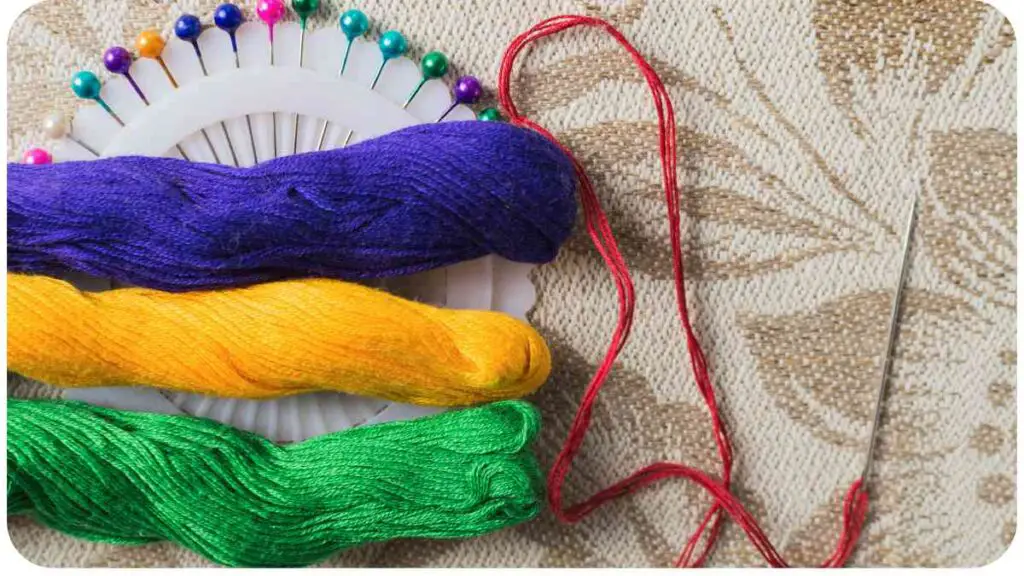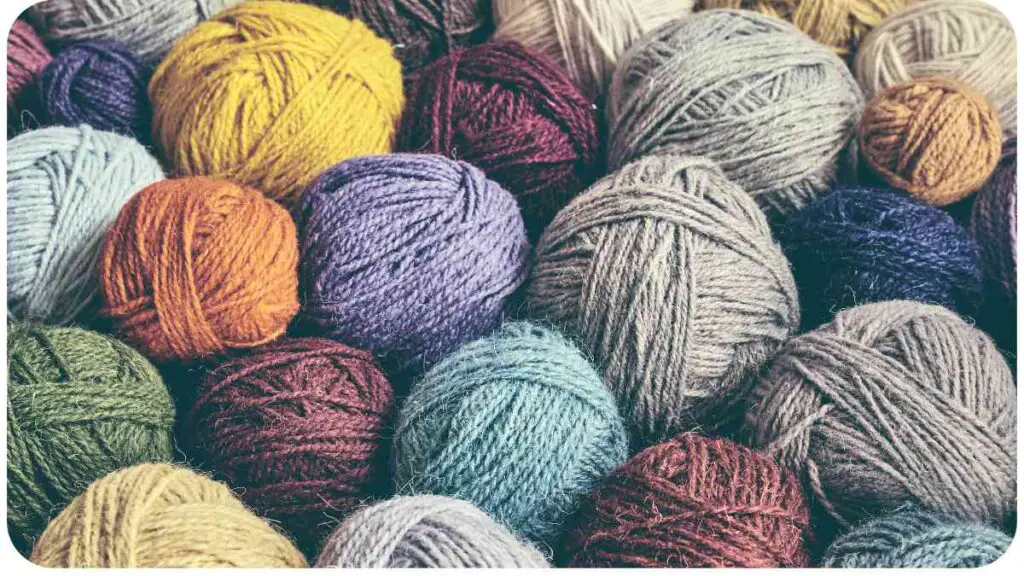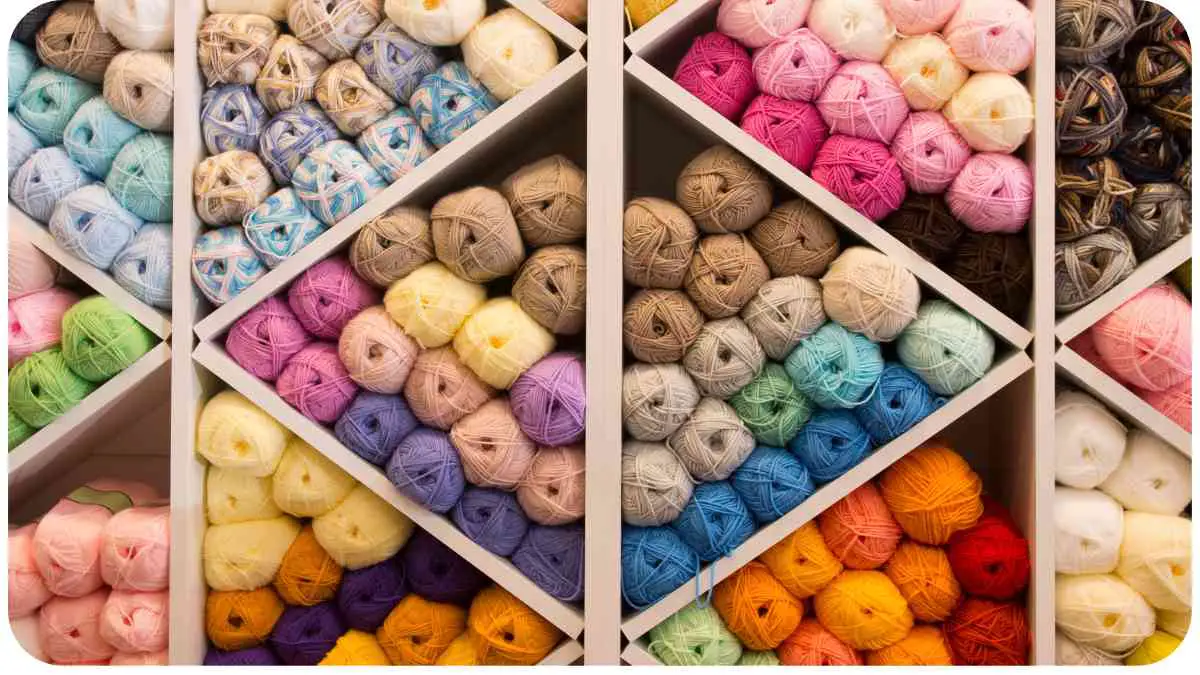Welcome to our comprehensive guide on identifying wool yarn. As a seasoned yarn enthusiast, understanding the characteristics of different yarn fibers is crucial when starting a new project or working with existing yarn supplies.
In this article, we will delve into the topic of identifying wool yarn and provide you with valuable tips, insights, and anecdotes from our own experiences. By the end of this guide, you will be equipped with the knowledge to confidently recognize wool yarn and differentiate it from other fiber types.
| Takeaways |
|---|
| Identify different types of wool yarn by visually inspecting the color and texture. |
| Perform burn tests to determine the fiber content of yarn. Wool yarn burns slowly and smells like burning hair. |
| Consider conducting a water test to see if the yarn absorbs water, as wool has natural crimp that allows it to absorb moisture. |
| Use a microscope to examine the fiber structure, looking for overlapping scales and distinct crimp patterns, which are indicative of wool. |
| Understand the characteristics of popular wool types such as Merino, Cashmere, Alpaca, Mohair, and Angora, and their common uses. |
| Explore common wool yarn blends like wool-acrylic, wool-cotton, wool-polyester, wool-silk, and wool-nylon, each offering unique qualities. |
| Follow proper care instructions for wool yarn, such as handwashing in lukewarm water and storing it in airtight containers to protect it from moths. |
| Regularly inspect your yarn stash for any signs of moth activity and take preventive measures to eliminate moth infestations. |
Understanding Fibers
Before we dive into identifying wool yarn, it’s important to have a basic understanding of different yarn fibers. Yarns can be made from a variety of materials, including wool, cotton, acrylic, silk, and many others.
Each fiber type has its own unique characteristics, which influence the yarn’s texture, elasticity, and performance. By familiarizing yourself with these characteristics, you will be better equipped to identify specific types of yarn.
Discover the perfect yarn for your crochet project with tips on choosing the right yarn. Learn about fibers and textures to enhance your creations and bring your vision to life.
Identifying Wool Yarn
When it comes to identifying wool yarn, there are several key methods you can employ. By combining visual inspection, touch, burning tests, water tests, and microscopic examination, you can determine whether a yarn is made from wool or another fiber. Let’s explore each method in more detail:
3.1 Visual Inspection
Begin by visually inspecting the yarn. Look for any labels or tags that indicate the fiber content, as some manufacturers provide this information. If the label is missing or unclear, you can rely on your visual examination. Wool yarn often has a distinctive appearance, with natural variations in color and texture that give it a unique charm. However, this method alone is not foolproof, as yarns can be dyed or artificially treated to mimic wool.
Explore the world of baby blankets and find out the best yarn options. From softness to durability, this guide provides insights into selecting the ideal yarn for cozy and beautiful baby blankets.
3.2 Feel and Texture
Next, feel the yarn in your hands and assess its texture. Wool yarn is known for its warmth and softness. It should feel cozy and slightly fluffy, with a certain springiness when squeezed. Pay attention to how the yarn slides through your fingers. Wool typically has a slight grip and may feel slightly oily due to natural lanolin oils present in the fiber.
3.3 Burning Test
The burning test is a useful method for differentiating between natural and synthetic fibers, including wool. It’s important to note that this test should be done with caution and safety precautions. Take a small snippet of the yarn and carefully light it with a flame. Observe how the yarn burns and the odor it emits. Wool yarn burns slowly, produces a charred smell similar to burning hair, and leaves behind a crumbly ash residue.
3.4 Water Test
The water test is particularly effective for identifying animal fibers like wool. Fill a bowl with warm water and add a few drops of mild detergent. Gently immerse a small portion of the yarn into the water and observe its behavior. Wool fibers have a natural crimp that allows them to absorb water. They will sink to the bottom of the bowl, whereas synthetic fibers tend to float. This test should only be performed if you plan to use or discard the tested yarn afterward.
Dive into the art of crochet with a comprehensive guide on understanding crochet hook sizes. Learn how the right hook size can impact your projects and discover the key factors in selecting the perfect crochet hook.
3.5 Microscopic Examination
For a more scientific approach to identifying wool yarn, a microscopic examination can provide detailed insights. By examining the yarn under a microscope, you can observe certain characteristics unique to wool fibers, such as scales, crimps, and medullations. This method requires more specialized equipment, but it can be highly accurate in identifying wool yarn. If you have access to a microscope, take a small strand of yarn and examine it under various magnifications. The presence of overlapping scales on the fiber surface and the distinct crimp pattern are indicative of wool.
Table 1: Comparison of Wool Yarn Characteristics
| Characteristic | Wool Yarn | Other Fibers |
| Visual | Varied natural color and texture, but can be dyed or treated | Can vary depending on fiber type |
| Feel and Texture | Warm, soft, slightly fluffy, springy, may feel slightly oily | Varies depending on fiber type and yarn processing |
| Burning Test | Burns slowly, smells like burning hair, leaves crumbly ash residue | Burns quickly and often melts, leaves hard plastic residue |
| Water Test | Absorbs water and sinks, animal fibers show natural crimp | Synthetic fibers repel water and tend to float |
| Microscopic | Overlapping scales, distinct crimp pattern | Varied characteristics depending on fiber type and structure |
Different Types of Wool Fiber

Now that we have explored the methods for identifying wool yarn, let’s take a closer look at the different types of wool fiber you may encounter in your yarn projects. Each type offers unique qualities and characteristics that can significantly impact your finished piece. Here are some popular wool types:
4.1 Merino Wool
Merino wool is renowned for its exceptional softness and warmth. It comes from Merino sheep, known for their fine, high-quality fleece. Merino wool is highly elastic, making it ideal for garments that require a good fit. It also has excellent moisture-wicking properties, keeping you warm and dry even in damp conditions.
Enhance the feel of your wool yarn with a step-by-step guide on how to soften your wool yarn. From washing techniques to conditioning, this resource provides practical tips to ensure your wool projects are soft and comfortable.
4.2 Cashmere Wool
Cashmere wool is a luxury fiber sourced from Cashmere goats. It is incredibly soft, lightweight, and cozy. Cashmere yarns are prized for their warmth and exquisite feel. Due to its delicate nature, cashmere is often blended with other fibers to enhance durability.
4.3 Alpaca Wool
Alpaca wool comes from the domesticated alpaca, a South American camelid. It is known for its warmth and natural luster. Alpaca fiber is hypoallergenic and softer than sheep’s wool. It is often blended with other fibers to create yarns with enhanced softness and drape.
4.4 Mohair Wool
Mohair wool is produced from the hair of the Angora goat. It has a distinct silky texture and a beautiful natural sheen. Mohair yarn is known for its durability and resistance to pilling. It is often used in knitting projects that require a fuzzy or fluffy appearance.
Troubleshoot common knitting issues effectively with a comprehensive guide on troubleshooting common knitting problems. From dropped stitches to uneven tension, this resource equips you with solutions to overcome challenges and improve your knitting skills.
4.5 Angora Wool
Angora wool comes from the fur of the Angora rabbit. It is incredibly soft and lightweight, providing excellent insulation. Angora yarn is often used for projects that require a fluffy, halo effect. It is essential to note that angora can cause allergies in some individuals, so it’s best to handle it with care.
Table 2: Comparison of Different Wool Types
| Wool Type | Characteristics | Common Uses |
| Merino Wool | Soft, warm, elastic, moisture-wicking | Sweaters, socks, base layers |
| Cashmere Wool | Luxuriously soft, lightweight, cozy | Scarves, shawls, high-end garments |
| Alpaca Wool | Warm, lustrous, hypoallergenic, soft | Hats, gloves, blankets, sweaters |
| Mohair Wool | Silky, durable, resistant to pilling | Fluffy scarves, blankets, plush toys |
| Angora Wool | Very soft, lightweight, provides insulation | Sweaters, hats, soft toys |
Common Wool Yarn Blends

In addition to pure wool yarn, you will often come across wool blends in the market. These blends combine wool with other fibers to create unique combinations that offer enhanced properties. Let’s explore some common wool yarn blends:
5.1 Wool-Acrylic Blend
Wool-acrylic blends offer the warmth and softness of wool along with the durability and washability of acrylic. This blend is popular for its affordability and easy maintenance. It is often used in projects that require both warmth and practicality.
5.2 Wool-Cotton Blend
Wool-cotton blends combine the natural qualities of wool with the breathability and softness of cotton. This blend is ideal for transitional seasons when you want warmth without overheating. It is often used in garments like lightweight sweaters and cardigans. The cotton content adds breathability and reduces the itchiness that some people experience with pure wool.
5.3 Wool-Polyester Blend
Wool-polyester blends combine the warmth and softness of wool with the durability and wrinkle resistance of polyester. This blend is known for its easy care and ability to retain its shape. It is often used for outerwear, blankets, and upholstery fabrics.
5.4 Wool-Silk Blend
Wool-silk blends offer the luxurious feel and drape of silk combined with the warmth and resilience of wool. This blend is perfect for projects that require a touch of elegance and a soft, smooth texture.
5.5 Wool-Nylon Blend
Wool-nylon blends combine the warmth and softness of wool with the added strength and durability of nylon. This blend is commonly used in socks, as the nylon content adds durability and reinforces high-wear areas.
Table 3: Wool Blends and Their Characteristics
| Wool Blend | Characteristics | Common Uses |
| Wool-Acrylic Blend | Warm, soft, affordable, easy maintenance | Hats, scarves, blankets |
| Wool-Cotton Blend | Breathable, soft, reduces itchiness | Lightweight sweaters, cardigans |
| Wool-Polyester Blend | Warm, durable, wrinkle-resistant | Outerwear, blankets, upholstery |
| Wool-Silk Blend | Luxurious, soft, smooth drape | Shawls, wraps, elegant garments |
| Wool-Nylon Blend | Warm, durable, reinforced strength | Socks, high-wear garments |
Caring for Wool Yarn
Proper care is essential to maintain the quality and longevity of your wool yarn projects. Here are some important tips for caring for wool yarn:
6.1 Washing and Drying
When washing wool yarn, it’s essential to follow the recommended care instructions provided by the manufacturer. In general, hand washing in lukewarm water with a gentle wool wash or mild detergent is ideal. Avoid agitating the fibers excessively, as this can lead to felting or shrinkage. After washing, gently squeeze out excess water without wringing. Lay the item flat to dry on a clean towel, reshaping it if necessary.
6.2 Storage Tips
To protect your wool yarn from moths and pests, store it in airtight containers or sealed bags. Add moth repellents like lavender sachets or cedar balls to deter insects. Keep the yarn in a cool, dry place away from direct sunlight to prevent color fading.
6.3 Preventing Moths
Moths can cause damage to wool yarn, so it’s important to take preventive measures. Regularly inspect your yarn stash for any signs of moth activity, such as small holes or insect larvae. If you discover an infestation, isolate the affected yarn and freeze it for a few days to kill any eggs or larvae. Vacuum the storage area and clean it thoroughly to remove any potential food sources for moths.
Conclusion
In conclusion, being able to identify wool yarn is a valuable skill for any yarn enthusiast. By incorporating visual inspection, feel and texture assessment, burning tests, water tests, and even microscopic examination, you can confidently determine whether a yarn is made of wool or another fiber.
Understanding different types of wool and common wool blends further expands your knowledge and allows you to choose the perfect yarn for your projects. Additionally, proper care and storage of wool yarn ensure its longevity and preservation.
Remember to always follow care instructions and take necessary precautions to protect your wool yarn from moths. With these tips and insights, you are now well-equipped to dive into the wonderful world of wool yarn and create beautiful, cozy creations.
Further Reading
Here are some additional resources you can explore to learn more about identifying wool yarn:
- How to Identify Yarn – WikiHow: This WikiHow article provides step-by-step instructions and visual cues to help you identify different types of yarn, including wool. It covers various identification methods and offers practical tips for distinguishing between different fibers.
- How to Identify Mystery Yarn – Roving Crafters: This blog post by Roving Crafters discusses the challenges of identifying unknown or mystery yarn. It provides insights and tips from an experienced yarn enthusiast, helping you tackle the task of identifying yarn with confidence.
- Is It Wool? Three Ways to Test for Fiber Content – TessKnits: TessKnits shares three effective methods for testing the fiber content of yarn, specifically focusing on the question of whether it is wool. The article explains the tests in detail and provides practical examples and comparisons.
FAQs
How can I tell if my yarn is made of wool?
To determine if your yarn is made of wool, you can employ several methods. These include visual inspection, feeling the texture, performing a burn test, and conducting a water test. Additionally, microscopic examination can provide more accurate results.
What does wool yarn feel like?
Wool yarn typically feels warm, soft, and slightly fluffy. It has a certain springiness and may feel slightly oily due to the presence of natural lanolin oils. It should provide a cozy and comfortable texture when held in your hands.
Can I use the burning test to identify wool yarn?
Yes, the burning test can be helpful in identifying wool yarn. Wool yarn burns slowly and gives off a distinctive smell similar to burning hair. It leaves behind a crumbly ash residue. However, it’s important to exercise caution and perform this test in a safe and controlled environment.
How do I care for wool yarn?
Caring for wool yarn involves following specific care instructions provided by the manufacturer. In general, handwashing in lukewarm water using a gentle wool wash or mild detergent is recommended. Avoid agitating the yarn too much and reshape it if necessary. Lay it flat to dry on a clean towel.
Can I store wool yarn for a long time?
Yes, you can store wool yarn for an extended period by taking proper precautions. It’s best to store it in airtight containers or sealed bags to protect it from moths and pests. Adding moth repellents like lavender sachets or cedar balls can help deter insects. Keep the yarn in a cool, dry place away from direct sunlight to prevent color fading.

My name is Hellen James, and I’m a crochet and knitting expert. I’ve been crocheting since I was just a kid, but I started taking it seriously when I realized that it was a great way to de-stress and relax. Now that I have kids of my own, I love teaching them how to do it too!

